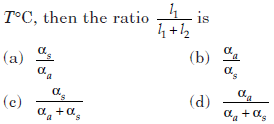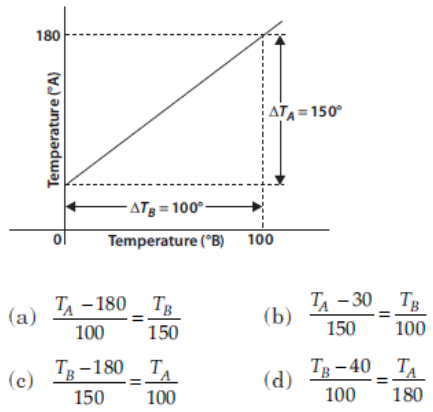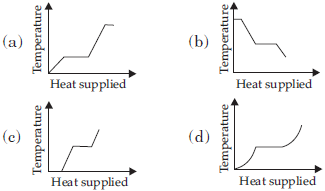Refer to CBSE Class 11 Physics Thermal Properties of Matter MCQs Set C provided below available for download in Pdf. The MCQ Questions for Class 11 Physics with answers are aligned as per the latest syllabus and exam pattern suggested by CBSE, NCERT and KVS. Chapter 10 Thermal Properties of Matter Class 11 MCQ are an important part of exams for Class 11 Physics and if practiced properly can help you to improve your understanding and get higher marks. Refer to more Chapter-wise MCQs for CBSE Class 11 Physics and also download more latest study material for all subjects
MCQ for Class 11 Physics Chapter 10 Thermal Properties of Matter
Class 11 Physics students should refer to the following multiple-choice questions with answers for Chapter 10 Thermal Properties of Matter in Class 11.
Chapter 10 Thermal Properties of Matter MCQ Questions Class 11 Physics with Answers
Question: The coefficient of thermal conductivity depends upon
a) temperature difference between the two surfaces.
b) area of the plate
c) material of the plate
d) all of the options
Answer: c
Question: Two absolute scale A and B have triple points of water defined to be at 200 A and 350 B. The relation between TA and TB is
a) TA = 4/7 TB
b) TB = 4/7 TA
c) TA = 2/7 TB
d) TB = 2/7 TA
Answer: a
Question: The real coefficient of volume expansion of glycerine is 0.000597 per°C and linear coefficient of expansion of glass is 0.000009 per °C. Then the apparent volume coefficient of expansion of glycerine is
a) 0.000558 per °C
b) 0.00057 per °C
c) 0.00027 per °C
d) 0.00066 per °C
Answer: b
Question: Two rods, one of aluminium and the other made of steel, having initial lengths l1 and l2 are connected together to form a single rod of length (l1 + l2). The coefficient of linear expansion of aluminium and steel are aa and as respectively. If the length of each rod increases by the same amount, when their temperatures are raised by

Answer: c
Question: When a solid is converted into a gas, directly by heating then this process is known as:
a) Sublimation
b) Vaporization
c) Condensation
d) Boiling
Answer: a
Question: Two metal rods 1 and 2 of same lengths have same temperature difference between their ends. Their thermal conductivities are K1 and K2 and cross sectional areas A1 and A2, respectively. If the rate of heat conduction in rod 1 is four times that in rod 2, then
a) K1A1 = K2A2
b) K1A1 = 4K2A2
c) K1A1 = 2K2A2
d) 4K1A1 = K2A2
Answer: b
Question: The graph between two temperature scales A and B is shown in figure. Between upper fixed point and lower fixed point there are 150 equal division on scale A and 100 on scale B. The relationship for conversion between the two scales is given by

Answer: b
Question: Two identical rods of copper and iron are coated with wax uniformly. When one end of each is kept at temperature of boiling water, the length upto which wax melts are 8.4 cm amd 4.2 cm, respectively. If thermal conductivity of copper is 0.92, then thermal conductivity of iron is
a) 0.23
b) 0.46
c) 0.115
d) 0.69
Answer: a
Question: To increase the length of brass rod by 2% its temperature should increase by (a = 0.00002 °C-1)
a) 800 °C
b) 900 °C
c) 1000 °C
d) 1100 °C
Answer: c
Question: A black body is at a temperature 300 K. It emits energy at a rate, which is proportional to
a) (300)4
b) (300)3
c) (300)2
d) 300
Answer: a
Question: If a bar is made of copper whose coefficient of linear expansion is one and a half times that of iron, the ratio of force developed in the copper bar to the iron bar of identical lengths and cross-sections, when heated through the same temperature range (Young’s modulus of copper may be taken to be equal to that of iron) is
a) 3/2
b) 2/3
c) 9/4
d) 4/9
Answer: a
Question: An ideal gas is expanding such that PT 2 = constant. The coefficient of volume expansion of the gas is
a) 1/T
b) 2/T
c) 3/T
d) 4/T
Answer: c
Question: The densities of two substances are in the ratio 2 : 3 and their specific heats are 0.12 and 0.09 CGS units respectively. The ratio of their thermal capacities per unit volume is
a) 8 : 9
b) 1 : 2
c) 3 : 2
d) 4 : 9
Answer: a
Question: 22320 cal of heat is supplied to 100 g of ice at 0° C. If the latent heat of fusion of ice is 80 cal g-1 and latent heat of vaporization of water is 540 cal g-1, the final amount of water thus obtained and its temperature respectively are
a) 8 g, 100°C
b) 100 g, 90°C
c) 92 g, 100°C
d) 8 g, 100°C
Answer: c
Question: The fastest mode of transfer of heat is
a) conduction
b) convection
c) radiation
d) none of the options
Answer: c
Question: The density of water at 20°C is 998 kg/m3 and at 40°C 992 kg/m3. The coefficient of volume expansion of water is
a) 10-4/°C
b) 3 × 10-4/°C
c) 2 × 10-4/°C
d) 6 × 10-4/°C
Answer: b
Question: A metallic bar is heated from 0ºC to 100ºC. The coeficient of linear expansion is 10-5 K-1. What will be the percentage increase in length?
a) 0.01%
b) 0.1%
c) 1%
d) 10%
Answer: b
Question: Mercury thermometer can be used to measure temperature upto
a) 260°C
b) 100°C
c) 360°C
d) 500°C
Answer: c
Question: A bimetallic strip is made of aluminium and steel (aAl > asteel). On heating, the strip will
a) remain straight
b) get twisted
c) will bend with aluminium on concave side
d) will bend with steel on concave side.
Answer: d
Question: Heat travels through vacuum by :
a) convection
b) radiation
c) conduction
d) all of the options
Answer: b
Question: A 10 kW drilling machine is used to drill a bore in a small aluminium block of mass 8 kg. Find the rise in temperature of the block is 2.5 minutes, assuming 50% power is used up is heating the machine itself or lost to the surrounding.(Specific heat of aluminium = 0.91 J g-1 × °C-1)
a) 100 °C
b) 103 °C
c) 150 °C
d) 155 °C
Answer: b
Question: A piece of ice falls from a height h so that it melts completely. Only one-quarter of the heat produced is absorbed by the ice and all energy of ice gets converted into heat during its fall. The value of h is [Latent heat of ice is 3.4 × 105 J/ kg and g = 10 N/kg]
a) 136 km
b) 68 km
c) 34 km
d) 544 km
Answer: a
Question: A block of ice at -10°C is slowly heated and converted to steam at 100°C. Which of the following curves represents the phenomena qualitatively?

Answer: a
Question: A pendulum clock is 5 seconds fast at temperature of 15ºC and 10 seconds slow at a temperature of 30ºC. At what temperature does it give the correct time? (take time interval =24 hours)
a) 18ºC
b) 20ºC
c) 22ºC
d) 25ºC
Answer: c
Question: The quantities of heat required to raise the temperatures of two copper spheres of radii rr1 and r2 (r1 = 1.5r2) through 1 K are in the ratio of
a) 27/8
b) 9/4
c) 3/2
d) 1
Answer: a
Question: Two spheres of the same material have radii 1 m and 4 m and temperatures 4000 K and 2000 K respectively. The energy radiated per second by the first sphere is
a) greater than that by the second
b) less than that by the second
c) equal in both cases
d) the information is incomplete to draw any conclusion
Answer: c
Question: A black body is heated from 27°C to 127°C. The ratio of their energies of radiation emitted will be:
a) 9 : 16
b) 27 : 64
c) 81 : 256
d) 3 : 4
Answer: c
Question: The density of water at 20°C is 998 kg/m3 and at 40°C is 992 kg/m3. The coefficient of volume expansion of water is
a) 3 × 10-4/°C
b) 2 × 10-4/°C
c) 6 × 10-4/°C
d) 10-4/°C
Answer: a
| CBSE Class 11 Physics Motion in a Plane MCQs Set A |
| CBSE Class 11 Physics Motion in a Plane MCQs Set B |
| CBSE Class 11 Physics Motion in a Plane MCQs Set C |
| CBSE Class 11 Physics Work Energy and Power MCQs Set A |
| CBSE Class 11 Physics Work Energy and Power MCQs Set B |
| CBSE Class 11 Physics Work Energy and Power MCQs Set C |
| CBSE Class 11 Physics Systems of Particles and Rotational Motion MCQs Set A |
| CBSE Class 11 Physics Systems of Particles and Rotational Motion MCQs Set B |
| CBSE Class 11 Physics Gravitation MCQs Set A |
| CBSE Class 11 Physics Gravitation MCQs Set B |
| CBSE Class 11 Physics Gravitation MCQs Set C |
| CBSE Class 11 Physics Thermodynamic MCQs Set A |
| CBSE Class 11 Physics Thermodynamic MCQs Set B |
| CBSE Class 11 Physics Thermodynamic MCQs Set C |
| CBSE Class 11 Physics Kinetic Theory MCQs Set A |
| CBSE Class 11 Physics Kinetic Theory MCQs Set B |
| CBSE Class 11 Physics Oscillations MCQs Set A |
| CBSE Class 11 Physics Oscillations MCQs Set B |
| CBSE Class 11 Physics Oscillations MCQs Set C |
| CBSE Class 11 Physics Waves MCQs Set A |
| CBSE Class 11 Physics Waves MCQs Set B |
| CBSE Class 11 Physics Waves MCQs Set C |
| CBSE Class 11 Physics Waves MCQs Set D |
| CBSE Class 11 Physics MCQs Set 1 |
| CBSE Class 11 Physics MCQs Set 2 |
| CBSE Class 11 Physics MCQs Set 3 |
| CBSE Class 11 Physics MCQs Set 4 |
| CBSE Class 11 Physics MCQs Set 5 |
| CBSE Class 11 Physics Physical World MCQs Set A |
| CBSE Class 11 Physics Physical World MCQs Set B |
MCQs for Chapter 10 Thermal Properties of Matter Physics Class 11
Expert teachers of studiestoday have referred to NCERT book for Class 11 Physics to develop the Physics Class 11 MCQs. If you download MCQs with answers for the above chapter you will get higher and better marks in Class 11 test and exams in the current year as you will be able to have stronger understanding of all concepts. Daily Multiple Choice Questions practice of Physics will help students to have stronger understanding of all concepts and also make them expert on all critical topics. After solving the questions given in the MCQs which have been developed as per latest books also refer to the NCERT solutions for Class 11 Physics. We have also provided lot of MCQ questions for Class 11 Physics so that you can solve questions relating to all topics given in each chapter. After solving these you should also refer to Class 11 Physics MCQ Test for the same chapter.
You can download the CBSE MCQs for Class 11 Physics Chapter 10 Thermal Properties of Matter for latest session from StudiesToday.com
Yes, the MCQs issued by CBSE for Class 11 Physics Chapter 10 Thermal Properties of Matter have been made available here for latest academic session
You can find CBSE Class 11 Physics Chapter 10 Thermal Properties of Matter MCQs on educational websites like studiestoday.com, online tutoring platforms, and in sample question papers provided on this website.
To prepare for Chapter 10 Thermal Properties of Matter MCQs, refer to the concepts links provided by our teachers and download sample papers for free.
Yes, there are many online resources that we have provided on studiestoday.com available such as practice worksheets, question papers, and online tests for learning MCQs for Class 11 Physics Chapter 10 Thermal Properties of Matter

